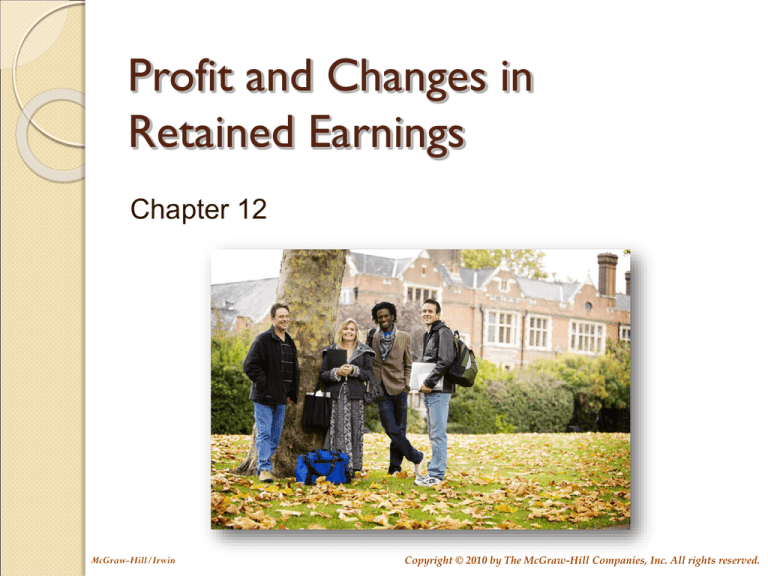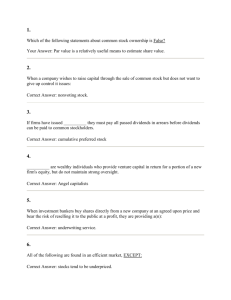
Profit and Changes in
Retained Earnings
Chapter 12
McGraw-Hill/Irwin
Copyright © 2010 by The McGraw-Hill Companies, Inc. All rights reserved.
Reporting the Results of
Operations
Information about profit can be divided
into two major categories
Normal, recurring revenue and
expense transactions.
Profit from
continuing
operations.
Unusual, nonrecurring events
that affect profit.
1. Results of
discontinued
operations.
2. Impact of
extraordinary
items.
12-2
Matrix Limited
Income Statement
For the Year Ended 31 December 2009
Sales
Cost of goods sold
Gross margin
Operating expenses:
Selling expenses
$ 1,500,000
General & admin. exp.
920,000
Loss on settlement of lawsuit
80,000
Income taxes
750,000
Profit from continuing operations
Discontinued operations
These unusual,
Profit for the year
nonrecurring items are
each reported net of
taxes.
$
$
9,000,000
4,000,000
5,000,000
This tax expense
does not include
effects of unusual,
nonrecurring items.
$
$
3,250,000
1,750,000
(175,000)
1,575,000
12-3
Discontinued Operations
When management enters into a formal plan to
sell or discontinue a component of a company,
the related gains and losses must be disclosed on
the income statement.
Discontinued
Operations
Profit/Loss from
operating the operation
prior to disposal.
Profit/Loss on disposal
of the operation.
12-4
Discontinued Operations
When management enters into a formal plan to
sell or discontinue a component of a company,
the related gains and losses must be disclosed
on the income statement.
A component is operations and
cash flows that can be clearly
distinguished, operationally and
for financial reporting purposes,
from the rest of the entity.
12-5
Discontinued Operations
During 2009, Matrix Limited sold an unprofitable
component of the company. The component had
a loss from operations during the period of
$150,000 and a loss on the sale of its assets of
$100,000. Matrix reported profit from continuing
operations of $1,750,000. All items are taxed at
30%.
How will this appear on the income statement?
12-6
Discontinued Operations
Loss on segment operations
Less: Tax benefits ($150,000 × 30%)
Loss
$ (150,000)
45,000
$ (105,000)
Loss on disposal of assets
Less: Tax benefits ($100,000 × 30%)
Loss
$ (100,000)
30,000
$ (70,000)
12-7
Discontinued Operations
Income Statement Presentation:
Profit from continuing operations
Discontinued operations:
Loss on operations (net of tax
benefit of $45,000)
Loss on disposal of assets (net of
tax benefits of $30,000)
Profit for the year
$ 1,750,000
(105,000)
(70,000)
$ 1,575,000
12-8
Extraordinary Items
•
•
Material in amount.
•
As many companies abused it, the IASB has
prohibited presentation or disclosure of
extraordinary items.
•
Some countries or places, e.g. US, still allow
such presentation
Gains or losses that are both unusual in nature
and not expected to recur in the foreseeable
future.
12-9
Earnings Per Share (EPS)
A measure of the company’s profitability and
earning power for the period.
Earnings
Per Share
=
Profit
÷
Weighted Average
Number of Shares
Outstanding
Based on the number of shares
issued and the length of time
that number remained
unchanged.
12-10
Earnings Per Share (EPS)
Remember that Matrix Limited has profit
from continuing operations of $1,750,000.
The after-tax loss from discontinued
operations was $175,000. Assume that
Matrix has 156,250 weighted average
shares outstanding.
Let’s prepare a partial income statement
using all this information.
12-11
Earnings Per Share (EPS)
Profit from continuing operations
Loss from discontinued operations
Income
Statement
Amounts
$ 1,750,000 $
(175,000)
Profit for the year
$ 1,575,000 $
EPS
11.20
(1.12)
10.08 *
$1,750,000 ÷ 156,250
* Rounded.
12-12
Earnings Per Share (EPS)
If preference share is present, subtract preference
dividends from profit prior to computing EPS.
Earnings
Per Share
=
Profit
- Preference Dividends
Weighted Average Number of
Ordinary Shares Outstanding
EPS is required to be
reported in the income
statement.
12-13
Other Comprehensive Income
Normally, there are 3 ways that
financial position can change.
Issuance of
new shares.
Profit or
Loss
Payment of
Dividends
IFRS excludes
some unrealized items from profit, such as the
change in market value of available-for-sale debt
and equity investments.
12-14
Other Comprehensive Income
IFRS requires that certain unrealized items that are
recognized in equity in the balance sheet be added
back to compute “Other Comprehensive Income.”
The total of profit and
other comprehensive
income for the year is
termed as total
comprehensive income.
The statement can then be
termed as Statement of
Comprehensive Income
There are 2 options for
reporting Other
Comprehensive Income.
Combined
with Profit on
the Income
Statement.
As a second
Income
Statement
12-15
Other Comprehensive Income
12-16
Cash Dividends
Declared by Board
of Directors.
Not legally
required.
Creates liability
at declaration.
Requires sufficient
Retained Earnings
and Cash.
12-17
Dividend Dates
Date of Declaration
• Board of Directors declares the dividend.
• Record a liability.
On 1 March 2009, the Board of Directors of Matrix
Limited declares a $1.00 per share cash dividend on
its 500,000 ordinary shares outstanding.
The dividend is payable to shareholders of record on
1 April, and paid on 1 May.
Date
Description
Mar. 1 Retained Earnings
Dividends Payable
Debit
Credit
500,000
500,000
12-18
Dividend Dates
Ex-Dividend Date
• The day which serves as the ownership
cut-off point for the receipt of the most
recently declared dividend.
Date
Description
Debit
Credit
Apr. 1
NO ENTRY
12-19
Dividend Dates
Date of Record
• Shareholders holding shares on this date
will receive the dividend. (No entry)
April 2009
X
12-20
Dividend Dates
Date of Payment
• Record the payment of the dividend to
shareholders.
Date
Description
May 1 Dividends Payable
Cash
Debit
Credit
500,000
500,000
12-21
Dividend Dates
On 1 June 2009, a corporation’s board of directors
declared a dividend for the 2,500 shares of its $100
par value, 8% preference share. The dividend will
be paid on 15 July. Which of the following will be
included in the 15 July entry?
a. Debit Retained Earnings $20,000.
b. Debit Dividends Payable $20,000.
c. Credit Dividends Payable $20,000.
d. Credit Preference share $20,000.
$100 × 8% = $8 dividend per share
$8 × 2,500 = $20,000 total dividend
12-22
Stock Dividends
Distribution of additional shares to
shareholders.
No change in total
shareholders’ equity.
No change in par
values.
All shareholders retain
same percentage
ownership.
12-23
Entries to Record
Stock Dividends
In accounting for a relatively small stock dividend
(say, less than 20%), the market value of the new
shares is transferred from Retained Earning account
to the share premium accounts. This process is
sometimes called “capitalizing” retained earnings.
On 1 June, Aspen Corporation has outstanding 1,000,000
shares of $1 par value ordinary share with a market value
of $25 per share. The company declares a 5% stock
dividend on this date. The dividend is distributable on 15
July to shareholders of record on 20 June. Let’s look at
the journal entries.
12-24
Entries to Record
Stock Dividends
Ordinary shares outstanding
Stock dividend percent
Additional shares issuable
Market value per share
Amount assigned to dividend
1,000,000
5%
50,000
$
25
$ 1,250,000
Additional shares issuable
Par value per share
Change in ordinary share account
50,000
1
50,000
$
12-25
Dividend Dates
Date of Declaration
• Board of Directors declares the dividend.
• Do not record a liability.
Date
Description
Jun. 1 Retained Earnings
Stock Dividend to be Distributed
Share Premium: Stock Dividend
Debit
Credit
1,250,000
50,000
1,200,000
500,000 shares × $1 par value
12-26
Dividend Dates
Ex-Dividend Date
• The day which serves as the ownership
cut-off point for the receipt of the most
recently declared dividend.
Date
Description
Debit
Credit
Jun. 20
NO ENTRY
12-27
Dividend Dates
Date of Record
• Shareholders holding shares on this date
will receive the dividend. (No entry)
June 2009
X
12-28
Dividend Dates
Date of Payment
• Record the payment of the dividend to
shareholders.
Date
Description
Jul. 15 Stock Dividend to be Distributed
Ordinary Share
Debit
Credit
50,000
50,000
12-29
Reasons for Stock Dividends
Management often finds stock dividends
appealing because they allow management to
distribute something of perceived value to
shareholders while conserving cash which may
be needed for other purposes.
Shareholders like stock dividends because they
receive more shares, often the share price does
not fall proportionately, and the dividend is not
subject to income taxes (until the shares
received are sold).
12-30
Distinction between Share Splits
and Stock Dividends
The difference between a stock dividend and a
share split lies in the intent of management and
the related issue of the size of the distribution. A
stock dividend usually is intended to substitute
for a cash dividend and is small enough that the
market price of the share is relatively unaffected.
Stock dividends do not result in a change in the
par value of the share. On the other hand, share
splits result in a pro rata reduction in the par
value of the share.
12-31
Summary of Effects of Stock
Dividends and Share Splits
Small Stock
Dividend
Large Stock
Dividend
Share Splits
Total
Shareholders'
Equity
Ordinary Share
Share Premium
No Effect
No Effect
No Effect
Increases
Increases
Increases
No Effect
No Effect
No Effect
Retained Earnings
Decreases
Decreases
No Effect
Increases
Increases
Increases
No Effect
No Effect
Decreases
Number of Shares
Outstanding
Par Value per
Share
12-32
Retrospective Application and
Retrospective Restatement
• Change in accounting policy
retrospective application
(unless specified by IFRS)
• Correction of error (prior period error)
retrospective restatement
Adjust retained
earnings
retroactively.
The adjustment
should be
disclosed net of
any taxes.
12-33
Restrictions of Retained Earnings
If I loan your company $1,000,000,
I will want you to restrict your
retained earnings in order to limit
dividend payments.
Loan agreements can include
restrictions on paying dividends below a
certain amount of retained earnings.
12-34
Statement of Changes in Equity
12-35
Shareholders’ Equity Section of
the Balance Sheet
Simmons Limited Shareholders' Equity
Share capital:
Ordinary shares - $10 par value; 50,000 shares
authorized; 30,000 shares issued and
outstanding
$ 300,000
Preference shares - $100 par value; 1,000 shares
authorized; 500 shares issued and
outstanding
50,000
Share premium
From issuance of ordinary shares
375,000
From issuance of preference shares
10,000
Total issued and paid capital
735,000
Retained earnings
116,500
Total shareholders' equity
$ 851,500
12-36
End of Chapter 12
12-37






